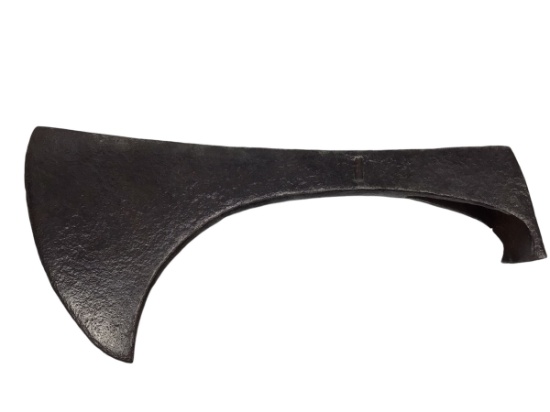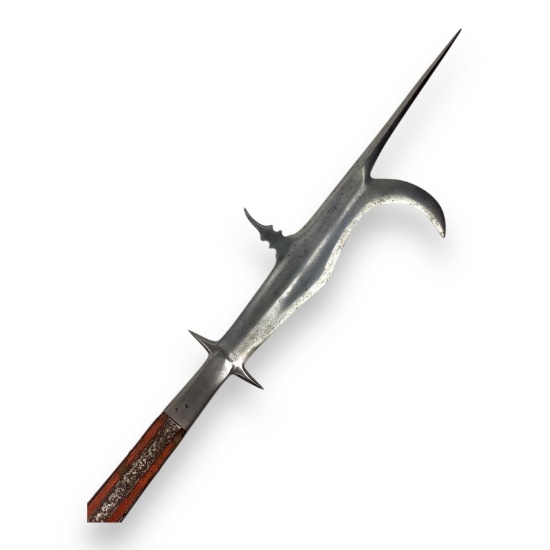
Militaria - Arms & Armor Through the Ages
Militaria - Arms & Armor Through the Ages
See Special Terms for additional fees
Description
This extraordinary event is structured in a way to give you, the bidders, an experience the progression of military history from the ancient Bronze Age through to World War II. Each era is represented by swords, armor, firearms, medals, and all sorts of battlefield relics, offering a glimpse into the weapons and protection used by warriors of different times.
From Viking swords and medieval plate armor to Napoleonic firearms and a wide range of World War II memorabilia, this auction captures the advancements, craftsmanship, and legacies of armed conflict through the ages.
Whether you are a collector, historian, or passionate enthusiast, don’t miss this unique opportunity to own a tangible piece of history.
Register now and take part in this remarkable journey through time!
Visigoth Warrior Belt Buckle - Small - 6thC-7thC A.D.
Lot # 1051 (Sale Order: 26 of 304)
The Visigoths were part of the Goths, an East Germanic people. They first appeared in the Balkans as a military group allied with the Romans. Their migration and sacking of the Roman Empire and Rome in 410 CE was one of the many reasons for the empire's fall in 476 AD. They established kingdoms in Gaul and Spain that lasted until the early 8th century.
Provenance: Part of a large York, UK Collection.
Dimensions: Approx.
Scandinavian Viking Warrior Bearded Battle Axe Head Est. 1000 AD Excavated
Lot # 1052 (Sale Order: 27 of 304)
"This artifact provides a direct link to the legendary Norse warriors who shaped medieval history, making it a significant piece of some of the earliest military heritage.
Provenance: A fine European Collection from the 1980s.
Dimensions: Approx. 5.75"Lx6.25"W 1.4LBS
Broken Viking Helmet Skull Cap version in Excavated damaged condition
Lot # 1053 (Sale Order: 28 of 304)
As an excavated piece, this particular helmet shows signs of damage, as seen in the images, likely from centuries of burial or damage sustained in battle. Unlike the elaborate horned helmets of modern myth, historical Viking helmets were practical and functional, prioritizing durability over decoration. The rounded shape helped deflect blows, offering essential protection in combat. Helmets were highly valued, often passed down through generations or taken as spoils of war. In some cases, they even doubled as cooking vessels, showcasing the Viking emphasis on resourcefulness and efficiency. A large piece broke off and has been repaired.
Provenance: A fine European Collection from the 1980s.
Dimensions: Approx.
Very Important Early Viking Era Behmer Type 8 Iron Sword 650-800 A.D.
Lot # 1054 (Sale Order: 29 of 304)
Excessive wear is visible from the tip to the middle of the blade on the downswing side, indicating heavy use in battle. The hilt, which was likely made of wood or bone, has been lost to time. Viking swords were extremely valuable and not produced in large quantities, making them accessible only to kings, chieftains, and their closest warriors. The average Viking warrior wielded axes, spears, or bows, making early swords like this exceptionally rare.
This sword stands as a testament to the brutal and honor-bound nature of Viking warfare. It may have been wielded during raids on the British Isles, Francia, or even along the rivers of Eastern Europe. A weapon of both prestige and lethality, this sword carries the stories of warriors who shaped the Viking Age.
Provenance: Purchased at the City of Wolin (an island in northern Poland that was a main Viking site) at the Slav and Viking Festival in 2024. This sword has been professionally preserved.
Dimensions: Approx. 36" L x 5" W 2.5LBS
Important Viking Era Petersen Style L Iron Sword dating late 9th - early 10th Century A.D.
Lot # 1055 (Sale Order: 30 of 304)
Provenance: This sword was discovered in 2021 in Northern Poland and has been professionally preserved
Dimensions: Approx. 36" L x 8.5" W
Medieval Bronze Gilt St. George & Dragon Buckle Plate 13th-14th Century A.D
Lot # 1056 (Sale Order: 31 of 304)
Provenance: Red House Antique Center York UK
Dimensions: Approx.
Medieval Iron Crossbow Bolt, C. 14th-15th Century AD
Lot # 1057 (Sale Order: 32 of 304)
Provenance: Acquired from part of a large collection in York, UK
Dimensions: Approx.
Medieval Crusader Knight's Long Sword Oakeshott Type X with "G" Disk Pommel 10th - 13th Century
Lot # 1058 (Sale Order: 33 of 304)
Whether wielded by a Crusader in the Levant or a European knight defending his homeland, this weapon remains an enduring symbol of medieval chivalry and historical warfare.
Provenance: This sword was part of a larger Polish collection acquired in 2020 and had been professionally preserved.
Dimensions: Approx. 29" in blade length and 36" overall 2.6LBS
Medieval Iron Crossbow Bolt, C. 14th-15th Century AD
Lot # 1059 (Sale Order: 34 of 304)
Provenance: Acquired from part of a large collection in York, UK
Dimensions: Approx.
Museum Quality Early Renaissance Morning Star Battle or Ceremonial Mace 16th - 17thC A.D.
Lot # 1060 (Sale Order: 35 of 304)
The Morning Star was a favored weapon of the 16th and 17th centuries, often wielded by mercenaries, foot soldiers, and knights. Its design allowed for effective strikes against both armored and unarmored opponents, making it a preferred choice for battlefield skirmishes. Imagine a fully suited warrior charging through the field wielding this massive, spiked mace... Whether used in combat or as a status symbol, this mace embodies the ferocity and craftsmanship of the Renaissance era.
Provenance: From a high-end German Arms & Armor Collection.
Dimensions: Approx.
Victorian Medieval Hape Mon's Warhammer
Lot # 1061 (Sale Order: 36 of 304)
Provenance: From a high-end German Arms & Armor Collection.
Dimensions: Approx. 34"Lx8.5"W 2.6LBS
European Renaissance Large Triangular Head Spear Circa 1490 A.D.
Lot # 1100 (Sale Order: 37 of 304)
Spears like this were favored for their versatility and ease of use, allowing even unskilled soldiers to become formidable opponents on the battlefield. Designed to stop cavalry charges and pierce armor, this spear was a critical tool for infantry formations, providing reach and accuracy at closer ranges, leading to a new strategic advantage in melee combat.
Provenance: A world-renowned US Armor and Weapons Dealer with impeccable provenance.
Dimensions: Approx. 84 inches total length, 23-inch blade
European Renaissance Italian Randistocco / German Runka Circa 1520
Lot # 1101 (Sale Order: 38 of 304)
Provenance: A world-renowned US Armor and Weapons Dealer with impeccable provenance.
Dimensions: Approx. Total length is 90 inches (7 ft), with a 24-inch blade!
European Massive Executioner Beheading Axe Head est. 1550-1700 A.D.
Lot # 1102 (Sale Order: 39 of 304)
This piece represents not just a tool of capital punishment but also an instrument tied to power, law, and the societal order of early modern Europe. Such axes were used in public executions, often drawing large crowds, and have come to symbolize the ultimate enforcement of justice during that time. For those fascinated by the legal and punitive history of Europe, or the darker aspects of human history, this massive executioner’s axe is a must-have. It embodies the drama, authority, and finality of the historical period, making it a truly extraordinary piece for any buyer.
Provenance: From a high-end German Arms & Armor Collection.
Dimensions: Approx.14.25"Wx7.5"H 5.3LBS
Italian Renaissance Period Ronca or Roncone with Makers Mark Circa 1560
Lot # 1103 (Sale Order: 40 of 304)
Provenance: A world-renowned US Armor and Weapons Dealer with impeccable provenance.
Dimensions: Approx.
Italian Renaissance Halberd Circa 1580
Lot # 1104 (Sale Order: 41 of 304)
Provenance: A world-renowned US Armor and Weapons Dealer with impeccable provenance.
Dimensions: Approx. 7.25ft (87in) Total & 22in Blade
European Renaissance Friuli or Spetum Spear Polearm Circa 1580
Lot # 1105 (Sale Order: 42 of 304)
Provenance: A world-renowned US Armor and Weapons Dealer with impeccable provenance.
Dimensions: Approx. 95 inches total, 26-inch blade
European Renaissance Era Partisan Polearm Circa 1590
Lot # 1106 (Sale Order: 43 of 304)
Provenance: A world-renowned US Armor and Weapons Dealer with impeccable provenance.
Dimensions: Approx. 91-inch total length, 32.5-inch blade
German Black and White Morion Helmet late 16thC - early 17thC ca. 1600
Lot # 1107 (Sale Order: 44 of 304)
The Morion was widely used by Spanish soldiers and European pikemen, the Morion offered practical protection while allowing for visibility and maneuverability in battle. Its curved brim, which rises at the front and back, helped deflect blows and projectiles. The Morion became synonymous with Spanish Conquistadors, as they wore similar helmets during their expeditions in the Americas. Its design was influenced by earlier medieval helms but was refined to suit Renaissance warfare, particularly in pike-and-shot formations. This piece captures the craftsmanship and historical significance of one of the most recognizable helmets of the period.
German Renaissance Halberd Circa 1600
Lot # 1108 (Sale Order: 45 of 304)
Dimensions: Approx. 98 inches total (roughly 8.15 ft!), and a 28-inch blade
Massive European Gothic Spear Circa 1500-1700 Original Shaft and Metal Lizard Sticker
Lot # 1109 (Sale Order: 46 of 304)
This European Gothic spear, dating from 1500-1700, retains its original wooden shaft and metal "lizard sticker" end cap. The massive spearhead features an equally as strong medial ridge, reinforcing its structure for better thrusting power and durability in combat. Likely used in shield wall formations, it was a key weapon in infantry engagements and remained largely unchanged over two centuries. This spear measures a total length of 83 inches while the blade measures 20.5 inches in length.
The spear is one of the oldest weapons in human history, first developed in the Paleolithic era for hunting. Early spears were sharpened sticks, later fitted with stone points for better penetration. Over time, they evolved into larger thrusting weapons and lighter throwing variants, becoming a dominant weapon of war due to their effectiveness and ease of use.
Provenance: A world-renowned US Armor and Weapons Dealer with impeccable provenance.
Dimensions: Approx. 83in total, 20.5in blade
Massive Rare Kliener .62 Caliber 16th Century Wheel-lock Rifle Converted to Flintlock
Lot # 1110 (Sale Order: 47 of 304)
NRA Fair+ / Antique firearm - no FFL transfer required.
Provenance: Acquired from a high-end German Arms & Armor Collection.
Dimensions: Approx. 52" in total length, with a barrel measuring 36.25"
English Civil War Sapper's Siege Helmet 1642-1651 A.D.
Lot # 1111 (Sale Order: 48 of 304)
Provenance: A fine UK Arms and Armor Collection specializing in English Civil War items.
Dimensions: Approx. 8.5"Wx16"Lx6.25"H 8.6LBS
English Civil War Cromwellian C 1650's Pikeman Helmet with Original Black Paint
Lot # 1112 (Sale Order: 49 of 304)
This example, with its original paint and strongly preserved construction, is a highly collectible piece from one of England’s most turbulent eras.
Dimensions: Approx. 12.25" W x 17" L x 9.5" H 11.8LBS
English Civil War c.1635 Cromwellian Harquebusier Cavalry/ Musketeer Lobster Tail Pot Helmet
Lot # 1113 (Sale Order: 50 of 304)
Key features of this helmet include its three-barred face protection, which shields the wearer while maintaining visibility, and its longitudinal comb, reinforcing the helmet’s structure against direct blows. The hinged and laminated cheekpieces, still attached to the skull via their original leather strapping!
The Vesque busier style, with its forward-projecting brim, helps deflect downward strikes, while the multi-riveted construction showcases the craftsmanship and durability of 17th-century armorers. This helmet was an essential piece of protective gear for Cromwell’s cavalry, used extensively by the Parliamentarian Roundheads as they clashed with Royalist forces.
Provenance: From a high-end German Arms & Armor Collection.
Dimensions: Approx. 10"Wx15.75"Lx7.5"H 11.7LBS


 x Cancel
x Cancel























